Tibetan Spaniel
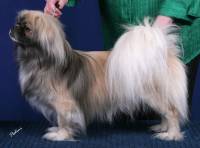 Tibetan Spaniel
Tibetan Spaniel
The Tibetan Spaniel is a small toy dog developed by eunuchs who ran the day-to-day affairs of the Emperors' Palaces in Tibet. They became constant companions of the Dalai Lama. The exchange of these small dogs as gifts between the Emperors of Lhasa, the capital of Tibet and Peking, the capital of China meant they played an important part in the development of the Pekingese.
History of the Tibetan Spaniel
 'Spirit-Lion' c 1700 AD
'Spirit-Lion' c 1700 AD
The precursor of the Tibetan Spaniel was first developed by the monks in the monasteries of Tibet around 600 A.D and called 'sleeve dogs'. Lamaism in Tibet is very similar to the Buddhism of China, together with grave statues like the ones shown here. There was also exchange of small 'lion-dogs' as gifts between the Emperors of Lhasa and Peking. As this journey took ten months traveling around 2,000 miles over steep mountains covered in ice and snow, these little 'lion-dogs' had to be extremely robust to survive[6].
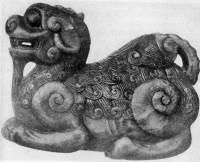 Jade Grave Image c 206 BC
Jade Grave Image c 206 BC
From around 500 A.D, small dogs became the earthly representation of the 'lion-dog' associated with Lamaism. Although this 'lion-dog' was not worshiped or used in sacrificial ceremonies, it appeared in religious ceremonials which secured its place among the superstitious.
The 'Spirit Lion-dog'
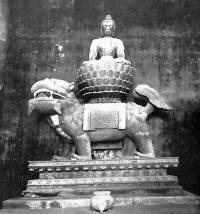 Buddha riding his Lion
Buddha riding his Lion
For example an early Lama Gospel states:
" The lion is the King of Beasts. It's power of increase is without limits. Similarly it may diminish and become like a dog. So is the anger of man"
This gospel then goes on to explain that a person who keeps his anger under control shall be free of disaster and distress. But if this person's fury fails to be bridled it will increase to the size of the lion. But when diminished, would turn back into a small 'spirit lion-dog'. So it is through this lion's form that the nature of anger became known to man[4]
The Tibetan Spaniel becomes a Pure Breed
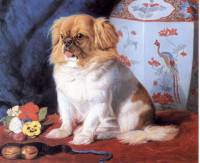 "Lootie'
"Lootie'
During the conflict of the Second Opium War of 1860, five Asian Spaniels were plundered from the Summer Palace when the British invaded Peking (now Beijing, China). One was appropriately named "Lootie"(pictured) was presented to Queen Victoria of England. "Lootie" became famous because of her charm and aristocratic manner and lived until she was 16 years of age. Of Tibetan Spaniel type, she and the other four dogs which came from the Summer Palace are considered to be the foundation of the Pekingese breed in England.
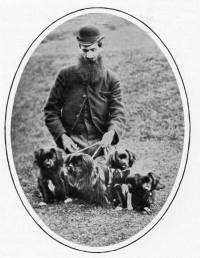 Thibet Spaniels 1907
Thibet Spaniels 1907
Tibetan Spaniels never worked as Land Spaniels as described in the History of Spaniels. Instead they were watchdogs, warning the large Tibetan Mastiffs of impending danger. This gave them some appeal to English where they were first introduced into England around 1900 and campaigned by the Hon. Mrs McLaren Morrison who believed the 'Thibet' Spaniel was the true ancestor of the Pekingese and Japanese Chin[5].
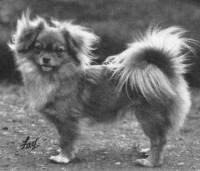 Tibetan Spaniel 1930
Tibetan Spaniel 1930
By 1930, the dog pictured was considered to be a remarkable bitch of ideal type. She was the property Mrs Greig of the Rozel Kennels in Royden Essex in England[3]. It is believed that these Tibetan Spaniels of this type were the ones from which the Pekingese in the Summer Palace developed[3a].
The Tibetan Spaniel Today
 Tibetan Spaniel
Tibetan Spaniel
Today, the Tibetan Spaniel has a body longer than its height at shoulder. He has a smallish head with a slight dome. His relatively high set ears may have a slight lift from the skull. His medium sized oval shaped eyes, and cushioning on his medium length of muzzle gives it a soft expression. His jaw should be wide housing a reverse scissors or undershot bite but a level bite is also acceptable.
 Tibetan Spaniel
Tibetan Spaniel
His medium length neck is covered by a beautiful mane, more so in males. The Tibbie's chest should come down to its elbows and his body should have a good spring of rib so his front legs are slightly bowed. His high set gaily carried tail is furnished with a beautiful plume. The Tibetan Spaniels' silky coat which can be any colour or mixture of colours, lies rather flat. Although double coated, it is smooth on the face and fronts of the legs. The Tibetan Spaniel stands around 10 inches (25 cms) high and weighs between 9 and 15 pounds (4.1 - 6.8 kg).
References and Further Reading
Published as - Jane Harvey "Ancient Breeds from Chinese Temples" Published in Dog News Australia (Top Dog Media Pty Ltd Austral NSW) Issue 1 January 2018, Pages 20 - 21
[1] 'Tyzack's Annual' Compiled by T. W.Tyzack and C.S.Turner, Published by the Victorian Poultry and Kennel Club 1912 by Bellamine Bros. Printers, 66-70 Flinders Lane Melbourne Pekingese Page 48 (Stud Book) and Page 101 (Importations). Pugs Page 32 (Stud Book) and Page 89 (Importations).
[2] Kim Dennis-Bryan and Juliet Clutton-Brock - 'Dogs of the Last Hundred Years at the British Museum' Published by British Museum (Natural History), London (1988) ISBN 0-565-01053-0 Page 101 Chinese Happa Dog and Page 98 Pekinngese 1890.
[3] Edward C Ash 'The Popular Dog Book' Published by Simpkin Marshall Ltd, London 1930 Page xxviii Plate 36
[3a] Ibid., Chapter 1X 'The Pekingese and its Relatives' The Thibetan Spaniels Page 171
[4] V.W.F. Collier, 'Dogs of China and Japan' Published by Frederick Company 1921 Chapter 5, 'The Chinese Lion' Page 103
[5] Robert Leighton, "The Book of the Dog" published circa 1905 Subscriber's Edition, The Waverley Book Co. Ltd. Chapter LX1 'Pet Dogs and Hairless Dogs, Page 538
[6] Gay Widdrington, 'Shih Tzu Handbook' Self Published Morpeth Northumberland UK 1971 'Tibetan Origin' Page 3